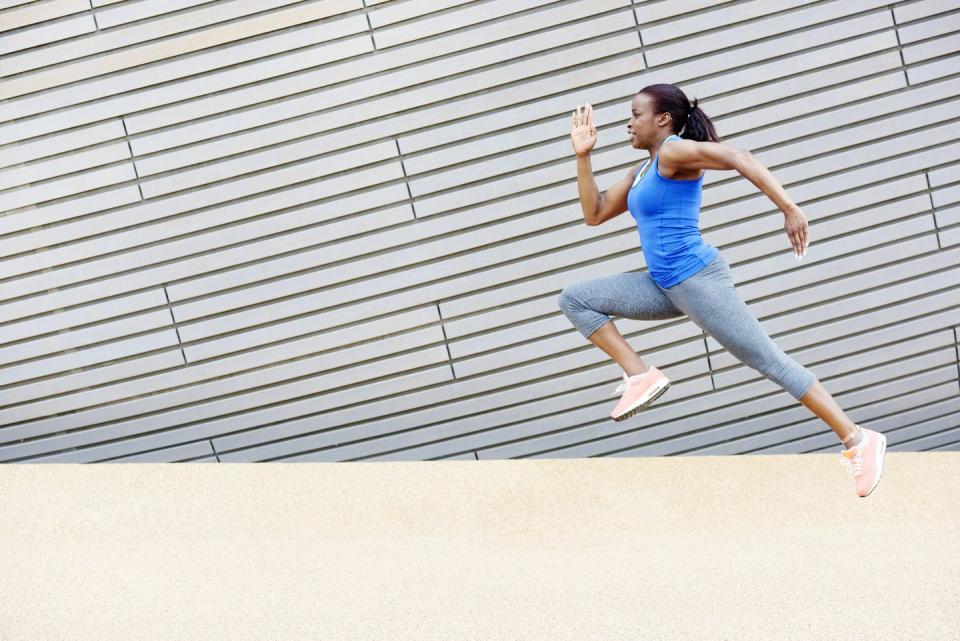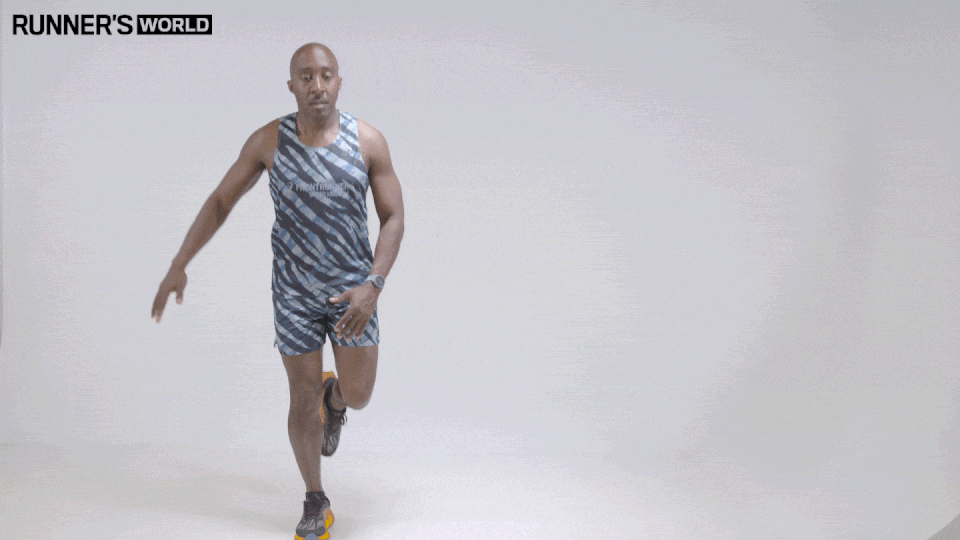Plyometrics: The benefits for runners and how to get started

Plyometrics is a term that can leave you scratching your head. What does it mean? Is it another term for Pilates? Or are we just getting our P’s confused? Does it involve – ugh– stretching? And how will it impact running performance?
In essence, plyometrics is a branch of exercise training involving fast, powerful movements that help to increase the strength and power of a person’s muscles. Runners require both strong and powerful muscles to propel themselves further for longer (and without getting injured), so plyometrics is an excellent addition to your training regime – regardless of the distance you’re targeting.
If you thought plyometric exercises were reserved for elite sprinters, think again. While this type of training is important for athletes competing over shorter distances, its value to middle- and long-distance runners – of all ages and abilities – should not be underestimated, as we’ll go on to explore below.
This 2024 study, for instance, published in the European Journal of Sports Science, found that a 10-week programme of plyometric training (performed twice a week on nonconsecutive days) improved running economy in middle-aged recreational runners.
By adding just one plyometric workout into your schedule each week, you can train your muscles to stretch and contract more effectively, crafting you into a faster, more efficient runner who is ripe to achieve a new PB. One 2023 study published in Scientific Reports found that even just five minutes a day of an easy-to-learn double-legged hopping exercise improved running economy in amateur runners.
What are plyometrics?
To dial into the specifics and benefits of plyometrics, we asked chartered physiotherapist Kate Cadbury to break down exactly what this type of training involves.
‘Plyometrics are exercises that involve fast explosive movements such as skipping and jumping,’ says Cadbury. ‘They use speed and maximal force over short periods of time and build muscle power.’
To achieve this, plyometric exercises use the elastic recoil of muscles and stretch reflex to produce a faster, stronger muscle response. ‘When performing plyometrics, you get a stretch of the muscle – eccentric contraction – followed by an immediate powerful contraction of the muscle – concentric contraction,’ she continues.
‘This is also known as the stretch-shortening cycle, and it helps to improve explosive power and muscle efficiency. The movements are fast as the aim is to have minimal contact time with the ground, and the goal is to bounce back off the surface as quickly as possible – as per the action of running.’
It’s been reported that double 1500m Olympic gold medallist Seb Coe – considered one of the greatest middle-distance athletes of all time and known for his ‘double kick’ and general power – implemented regular plyometric exercises into his training.
How can plyometric training improve a runner’s performance?
Luckily for us, there has been plenty of research into the benefits of plyometrics for runners. As we’ve already touched on, a number of studies have shown that this type of exercise can have a positive effect on running economy and speed.
One study published in the Journal of Strength & Conditioning Research, for example, tracked non-elite runners over a six-week period following the introduction of a weekly plyometric workout. The runners completed a 2.4K run at the start of the study, then another 2.4K run at the end. The second 2.4K run saw faster times across the board, with researchers noting that both the participants’ explosive strength and running speed had increased.
What’s more, a 2024 systematic review found that runners who followed a plyometric training programme for six weeks, again, enjoyed an 11% improvement in performance.
And in this 2016 study published in the Journal of Sport and Health Science, researchers examined the effects of 12 sessions of plyometric training (performed twice per week) on moderately trained male endurance runners. The result was improved 10K running performance (and peak power) despite a reduction in training mileage.

‘Performing plyometrics can increase your number of fast-twitch muscle fibres, which helps to improve your sprinting and speed ability,’ says Cadbury. ‘This can make you faster at running over short distances and also helps you to power up hills with more ease.’
Sports scientist and Auster Fitness master trainer, Harry Aitken describes plyometrics as being ‘about exerting the maximum amount of force in the minimum amount of time’. He adds: ‘With the lower body, this typically means jumps – and with the upper body, it often involves launching a projectile, such as a ball.’ Did somebody say Hyrox Wall Balls?
And these improvements can come even if you’re already a very fast runner. One study, for instance, looked at runners who could run 5K in roughly 15 minutes. The runners were divided into four groups. For eight weeks, they either did pyramidal training, polarised training (essentially the 80/20 training method), or one of the two plus once-weekly plyometrics.
After the eight-week trial, those who did pyramidal training (which is similar to polarised training, but with slightly more tempo sessions) plus plyometrics improved their 5K times by 1.6% (which equates to 24 seconds off a 25-minute 5K). Meanwhile, those who did polarised training plus plyometrics improved their 5K times by 1.8% (which equates to 27 seconds off a 25-minute 5K). Those who did not add plyometrics to their training showed only marginal improvements over the 5K distance.
How do plyometrics help sprinters?
‘Plyometrics will feature heavily in the workouts of sprinters and short-distance track athletes,’ says Aitken. ‘This is because they are an excellent way to strengthen the muscles of the lower body and increase the tendon elasticity, thereby increasing speed.’
If performed regularly, you’ll slowly build your plyometric volume and, as a result, increase the elasticity of the achilles tendon, strengthen the calf, soleus and anterior tibialis muscles, and greatly strengthen the quadriceps and hamstrings.
‘By strengthening these, the risk of injury when subsequently running will also be greatly reduced, and fatigue will take longer to set in,’ adds Aitken, giving you yet another reason to start doing plyometric exercises.
This systematic review of randomised trials found that injury prevention programmes incorporating plyometric exercises substantially decreased the risk of ACL injuries more than warm-up programmes without plyometric exercises.
How can runners add plyometrics to their training plan?
If you’re already doing a weekly strength and conditioning routine, you can easily add a plyometrics session to your training to bolster your running progress. If you don’t do any form of strength training at the moment, it’s best to build up your strength first before tackling plyometric exercises, as they can stress your muscles if they aren’t used to performing them.
After a few weeks of base strength work, you can then begin to incorporate a few jumping-based exercises into your routine. Then, you can slowly transition to an entire plyometrics session.

Cadbury stresses the importance of building up your plyometric exercises gently rather than jumping (no pun intended) straight into them, as they are intense. ‘I advise runners to work on their overall strength and core stability initially by doing something like Pilates to allow them to maintain good control and form when doing plyometrics.’
After that, she recommends introducing one 30-minute plyometrics session a week into your training schedule. ‘Aim to perform three sets of 20 seconds of plyometrics, ensuring good form throughout, with a rest of one to two minutes between each set. It’s common to get DOMs [delayed onset muscle soreness] following this training, so ensure you’re fully rested before you do another plyometrics session.’
What are the best plyometric exercises for runners?
The great thing about plyometric exercises is that they require no equipment – all you need is your own body and, if you have one, an exercise mat (and even that’s not essential).
As Cadbury highlights, correct form is crucial when performing plyometric exercises. This not only helps your muscles to benefit fully from the moves, but also reduces your risk of getting injured. If you can, ask a personal trainer or coach to assess your form and provide advice as you perform the workout. If not, watch clips like the ones below to check that you are doing each exercise in the correct and most purposeful way. Then, you will quickly begin to see improvements in your explosive power and speed when running.
For starters, Cadbury suggests adding the following four plyometric exercises to your training schedule.
Jump squats

Jump squats, Cadbury notes, assist in building the explosive power of the glutes, quads, hamstrings and calf muscles.
Stand with your feet wider than hip-distance apart.
Squat down as low as you can, ensuring that you flex from the hips (by sticking out your bottom) and put weight through your heels. Keep your spine lengthened and lift your chest.
Jump straight up and out of the squat to land on the balls of your feet.
Repeat.
Bounding
When a new study tried to answer the question ‘what is the single best plyometric exercise in terms of improving ankle strength and, by extension, running economy?’, there was a one-word answer: bounding. ‘Bounding induced a higher positive ankle power than running,’ said researchers, as opposed to other plyometric exercises, such as A-skips, which required less power. Interested? Here’s how to bound for glory.
• Stand with feet hip width apart.
• Push off with left foot and jump out and forward as far as you can, landing on your right foot.
• Immediately, push off with your right foot, repeating the motion so you now land on your left foot.
• Together, bounding should look like exaggerated forward skipping.
Jump lunges
Jump lunges help to increase the single-leg explosive power of the glutes, quads, hamstrings and calf muscles. ‘They also build balance, dynamic control and single-leg stability,’ adds Cadbury.
Stand with your right leg forward and your left leg backward. Ensure you have a good distance between your legs so that when you lunge down, your front shin is parallel to the wall in front of you.
Lunge directly down to the floor.
Spring up and switch your legs so that your right leg goes backward and your left leg goes forward. You can drive with your arms, too.
Repeat.
Lateral hops

According to Cadbury, these are great for working on single-leg calf power and control.
Stand on one leg with your knee slightly bent.
Hop from one side to the other, imagining you’re hopping over a line or a rope.
Swap onto your other leg.
Burpees

‘A perennial classic for a reason,’ says Cadbury. ‘Burpees increase the explosive power of the quads, glutes, hamstrings and calf muscles and build upper body and core strength.’
Squat down, placing your hands on the floor.
Jump your legs backward into a plank position.
Perform a push-up.
Jump your feet forward to meet your hands and come into a squat.
Jump straight up and out of the squat to land on the balls of your feet.
Repeat.
You Might Also Like

